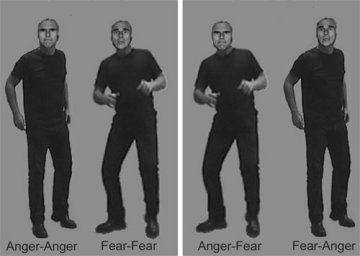Reading Body Language
The emotion that your body shows may have a stronger effect than what your face says.
Share this:
- Share via email (Opens in new window) Email
- Click to share on Facebook (Opens in new window) Facebook
- Click to share on X (Opens in new window) X
- Click to share on Pinterest (Opens in new window) Pinterest
- Click to share on Reddit (Opens in new window) Reddit
- Share to Google Classroom (Opens in new window) Google Classroom
- Click to print (Opens in new window) Print
By Katie Greene
It’s natural to greet friends with a smile and a wave. When you do this, your face and body work together to show your friends that you’re happy to see them. But what happens if your face and body send mixed messages? Would someone be more likely to believe the look on your face or the way you hold your body?
Scientists have recently tackled these questions. They found that when a person is looking at your face, she might not believe what she sees if your body language doesn’t match the feeling that your face shows.
 |
|
To find out how a person’s body language affects the emotional impression given by that person’s face, scientists used pictures in which body posture matched (left) and didn’t match (right) facial expression. |
| Proceedings of the National Academy of Sciences |
Studying such mixed messages is nothing new for scientists. Previously, they had found that the tone of a person’s voice can be more important than the words that are spoken. For example, most people tend not to believe a person who says in a flat voice, “I’m so excited.”
When it came to emotions conveyed by facial expressions and body language, most scientists suspected that the face was more important. To test if this was true, psychologists from the Netherlands and Boston showed people a number of pictures of isolated faces and isolated bodies (with faces blurred out) that showed anger or fear. They also showed pictures in which angry or scared faces were paired with angry or scared bodies.
An angry face had low eyebrows and tight lips. A scared face had high eyebrows and a slightly open mouth. An angry body had arms back and shoulders at an angle, as if ready to fight. A scared body had arms forward and shoulders square, as if ready to defend.
Using the pictures, the researchers asked people to quickly press a button that matched the correct facial emotion: anger or fear. When people looked only at faces, they chose the right emotion about 81 percent of the time. But when people looked at a mismatched picture—a scared face with an angry body, for example—they correctly guessed the emotion on the face only 64 percent of the time.
These results told the researchers that mixed signals can confuse people. Even when people pay attention to the face, body language subtly influences which emotion they read.
So, your body language is important for telling people how you feel. And if you want to be understood, it helps to avoid sending mixed messages.—K. Greene
Going Deeper:
Greene, Katie. 2005. Read my gestures: Body language can trump facial expressions. Science News 168(Oct. 29):278. Available at http://www.sciencenews.org/articles/20051029/fob7.asp .






